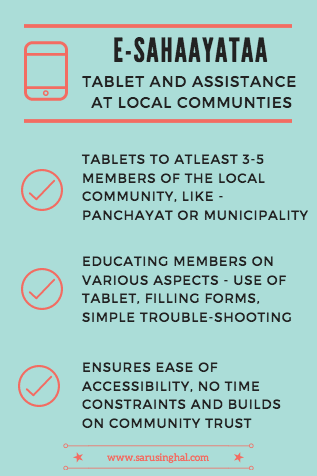The D(igital) Era
I come from a small village in Himachal Pradesh. There were times when my father travelled 100 kilometers to the main government office to fill a form, but thankfully things have changed in the last few years. Now he goes to the nearest local office or on some special occasions, a booth is set up by the government to make things easy for all the villagers - a voting registration booth or a local Aadhaar Card center. He says, ‘Time has changed and computer has made everything easy.’ However, there are some glitches - sometimes the computer doesn’t work, internet is slow, or the only person who knows how to operate the system is sick. #DigitalIndia sounds more of a plan for the urban India where infrastructure is better and people are computer literate. It is still an incomprehensible thing for many like my father.
Hence E-Governance falls flat most of the times. To pave the way for #DigitalEra, we need to simply things for the mass users in our country and this should start by aiding E-Governance projects.
Here are a few things which can make this journey smooth -
Simpler Technology And Assistance -
We all must have heard of Aakash tablet that was introduced by the Government to help students. It was an initiative where a low cost tablet was launched to link 25000 colleges and 400 universities to the e-learning program. Similarly e-kisan tablet was launched to help farmers. To facilitate e-governance in a better way, one such initiative should be launched wherein we can provide a table to help people fill forms, applications, raise complaints and get all the help they need. Now, there are PC kiosks where people get assistance with their work but these places have working hours and we all know that in the true sense, internet should be available to everyone as and when they need, irrespective of time boundaries. So, for the e-governance plan to have a smooth functioning, tablets launched under this program should be given to people at the local communities - like 3-5 members of a Panchayat who are capable of operating it and helping others whenever they want. Let’s call it - e-Sahaayataa program which will be more successful as it will have easy accessibility and will benefit from the in-built trust present in the community. E-Governance through technology will be smooth if technology is available at the grass root level. Of course, such tablets should be cost effective and efficient.
App to Simplify and Fasten Things -
It’s not that we don’t have technology in our country. The presence of it can be spotted everywhere and the majority of population uses it. There are 71 million active Facebook users in our country and over 50 million people use Whatsapp. Now, whatsapp is used not only to have conversation with friends and family but also for promoting and doing business these days. The catch is - applications like whatsapp are easy to use and have zero-to-no cost. To reach the majority of population in e-governance, an app should be introduced. According to a report, there will be 200 million smartphone users in India by 2016 and an app will surely pace up the cause of Digitalizing India. The app should help -
- To check the status of application or track any data required by an individual in one click.
- To update information faster by people, like - filing of land record, change of address and addition to the family member.
- To get updates of various schemes introduced by the government, like tax benefits for entrepreneurs and small businesses, reform for farmers and government jobs openings.
A simple app which uses Aadhaar Card Number as the login has the potential of changing the outlook of common man towards the e-governance program. By introducing an app, the number of people joining the e-governance will rise exponentially.
Infrastructure, Skills and IT Professionals’ Participation-
In the growth of any country infrastructure and literacy plays the most important role. How can we be tech savvy without computer or internet? And, what can we do with a computer without the skill to operate it? On the road to Digitalizing India these two are the challenging aspects. To counter these challenges, Intel has introduced two programs - Digital Skills for India and Innovate for India. Its Digital Skills Training Application comprises of modules on Digital Literacy, Financial Inclusion, Health care and Cleanliness in 5 Indian languages, whereas the offline model caters to 7 languages. As far as the infrastructure aspect goes, Intel along with Bharat Broadband Network Limited proposes to build capacity by imparting digital literacy training in the first 1000 Panchayats under the National Optic Fiber Network roll-out. And a tablet that can recognize instructions in regional language. All this will ensure that the right tone is set for this momentous task. However, in addition to that we can seek participation of trained IT professionals who can impart skills to local people. A voluntary program where those interested to help the government and want to be an active part of India’s growth register themselves and help in making people literate in technology, something like - Each One, Teach One. It will give language and region advantage. India had 32,890,000 IT professionals in 2014 and even if a small percentage commits to this cause, it will reach thousands. The voluntary program can be divided on the basis of - field of expertise, language and region.
By improving our infrastructure, easy availability and accessibility of technology and active participation from all sectors of society, we can fulfill the dream of #DigitalIndia at an accelerated speed. I hope there will come a time in near future when we won’t rush to government offices on last date to deposit bill and people like my father don’t have to travel miles to fill a simple form. It will all be done from the comforts of their home and without any help, and that will mark the beginning of Digital Era of India.
*Image Source for Collage - Here and Here






This was just brilliant, out of box:)
ReplyDeleteNice one Saru. I like the concept of - e-Sahaayataa, will recommend to DeitY when we have our next VC :) Cheers and all the best!
ReplyDeleteThis has certainly made life easier for the local folks. Hey by the way im from himachal too :)
ReplyDeleteWow, such a refined vision dealing with all sort of intricacies. Loved it Saru. As you said Digital India is not only for urban but also for rural, it should be towards unified development.
ReplyDeleteGood one and my best wishes for the contest ;-)
Nice one. We share our thoughts in a way.
ReplyDeleteBest
Katie
You've listed the teething problems which are delaying the success of Digital India Efforts of the present Government.Imagine the miracles of communication technology which,we're enjoying as a matter of right.
ReplyDeleteOf course a lot needs to be done still.
Good suggestions...Technology should reach to the farthest and remotest locations.
ReplyDeleteSo agree Saru, an all pervasion development would be required to implement effective governance.
ReplyDeleteSo true - the masses need to be helped to go digital.
ReplyDeleteWe were to get the Tabs from the college, but we never heard of it later. (Though it was 3 years back)
ReplyDeleteLets hope your defined version of Digital era comes to reality. Good luck!
Following your here with your this blog post and ohh You are just more than a Pro Blogger. What a lucid writing skills you have earned. Looking forward for further reading.
ReplyDeleteInsightful suggestions! Dear Government and those who are in power are you listening.
ReplyDeletemaking life easier :)
ReplyDeleteAll three points were quite brilliant Saru. You have hit the nail on the head by addressing all the problems India is facing in Digitalizing India.
ReplyDeleteYour points are quite right Saru, and as far as I can see, our Honorable Prime Minister has been asserting the use and potential of mobile apps as a viable solution to Governance and awareness problems. Though the idea of using the Adhaar card as login is quite lucrative for it would do something that SSN in the US manages to do, the Supreme court has noted that it is not mandatory, and hence, multiple alternatives need to be provided. Accountability is the direct problem of these issues.
ReplyDeleteA very good post!
Blasphemous Aesthete
Points are really nice :) All the best .. :)
ReplyDeletenice one!
ReplyDeleteHello Saru,
ReplyDeleteYou have made many good points here..it is obvious that you feel strongly about the issue.
I personally do not agree with using Adhar ID as login etc. based on the lessons learned in Western countries. Using a unique id as identifier is a big security risk, and gives easy access to people's personal information.
I have worked on many projects in banking, healthcare etc. that aimed to replace a Unique ID with a system generated number. There have been many advancements in information security,
and since Digital India is just getting started, I hope that they use those lessons and prevent
any mistakes at the upfront.
I love the 'e-sahayata' concept!!
@Everyone - Thank you so much for reading and your valuable comments.
ReplyDelete